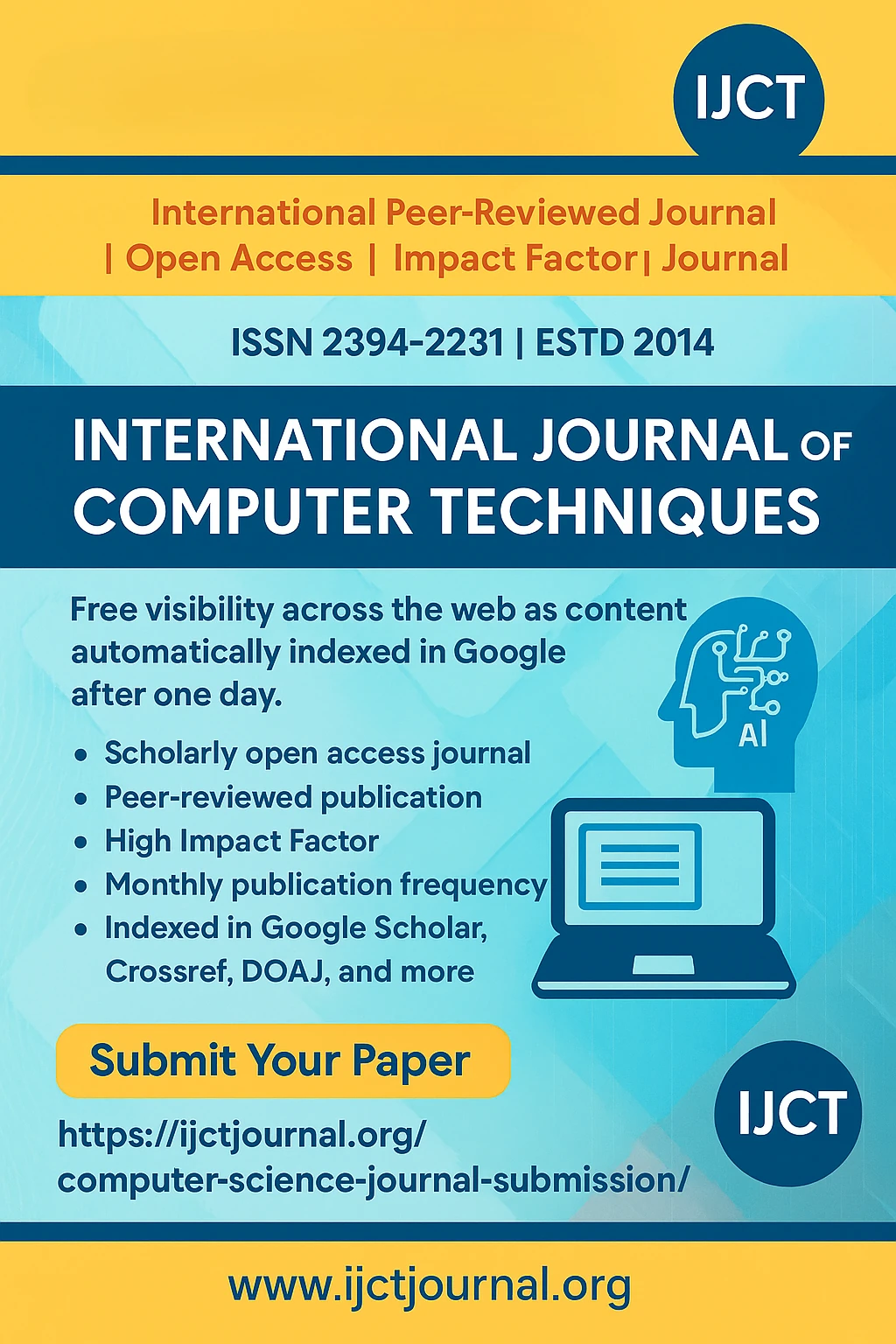
An Analytical Study of Human Factors in Cyber Security Threat Mitigation | IJCT Volume 12 – Issue 6 | IJCT-V12I6P10

International Journal of Computer Techniques
ISSN 2394-2231
Volume 12, Issue 6 | Published: November – December 2025
Author
Sanika Dattatray Bhujbal, Pragati Sham Dasgude, Rubina Sheikh
Abstract
Cybersecurity threats are increasing rapidly, but technology alone cannot ensure complete protection. Human behaviour plays a major role in preventing or causing security breaches. This study aims to analyze the human factors that influence cybersecurity threat mitigation. Data were collected through a structured Google Form survey focusing on users’ awareness, attitudes, and practices related to cybersecurity. The collected responses were analyzed using descriptive and statistical methods to identify common behavioural patterns and weaknesses. The results indicate that lack of awareness, negligence, and poor password management are the key factors contributing to security risks. The study highlights the importance of continuous cybersecurity training, awareness programs, and user- friendly security policies to strengthen overall threat mitigation efforts.
Keywords
Cybersecurity Awareness, Human Factors, Threat Mitigation, User Behaviour, Information Security.
Conclusion
In conclusion, the survey results show that people are aware of cybersecurity risks but do not always act safely. Only 16.7% always update passwords, while more than 70% do so irregularly. Around 61% have low familiarity with cyber threats, and over 57% still click on unknown links occasionally. This clearly proves that awareness alone is not enough to ensure safety—consistent behaviour and practice are just as important.
To improve cybersecurity at the human level, organizations and individuals need to focus on building habits, not just knowledge. Regular and simple training sessions, easy-to-follow security rules, and friendly reminders can help people act safely online. If these measures are applied consistently, the level of cyber risk caused by human error can be greatly reduced, leading to a safer digital environment for everyone.
Overall, the survey indicates that while awareness about cybersecurity and human errors is high, active reporting of suspicious activities is still low. To improve this, organizations should encourage regular reporting, simplify the reporting process, and conduct frequent workshops or online training sessions. Focusing on interactive learning and building a culture of responsibility can help reduce human mistakes and strengthen overall cybersecurity awareness among employees.
References
1.Taherdoost, H. (2024, September). Towards an Innovative Model for Cybersecurity Awareness Training. Information Journal. doi.org/10.3390/info15090512
2.Al-Badayneh, D. M., Al-Badayneh, D. D., & Hashish, R. K. (2025, April). Human Factors of Cybersecurity. Journal of Posthumanism. doi.org/10.63332/joph.v5i4.1242 3.Nurse, J. R. C., Milward, J., & Alashe, O. (2025, June). From Security Awareness and Training to Human Risk Management in Cybersecurity. Springer. doi.org/10.1007/978- 3-031-92833-8_6 4.Krasznay, C., & Hámornik, B. P. (2024). Human Factors Approach to Cybersecurity Teamwork – The Military Perspective. Acta Informatica Militaris et Technica. https://doi.org/10.3849/aimt.01296 5.Al-Kuwari, R. (2024, October). Enhancing Cybersecurity Awareness Training for Mitigating Human-Induced Cybersecurity Breaches. International Journal of Engineering and Computer Science. doi.org/10.18535/ijecs/v13i10.4917 6.Aggarwal, P., Venkatesan, S., Youzwak, J., Chadha, R., & Gonzalez, C. (2024). Discovering Cognitive Biases in Cyber Attackers’ Network Exploitation Activities: A Case Study. Advances in Human Factors in Cybersecurity. https://doi.org/10.54941/ahfe1004771 7.Helmiawan, M. A., Firmansyah, E., Herdiana, D., Hidayatul Akbar, Y., Subiyakto, A., & Abdul Rahman, T. K. (2025). Quantitative Analysis of Key Factors Driving Cybersecurity Awareness Among Information Systems Users. Journal of Information Technology and Informatics. https://doi.org/10.52436/1.jutif.2025.6.4.4861 8.Hossain, M. N., Khan, T. Z., Zaman, S. F. U., Sayeed, M. S., Ullah, S. M. W., & Raihan, M. J. (2023). Cyber Security and People: Human Nature, Psychology, and Training Affect User Awareness, Social Engineering, and Security Preparedness. Asian Journal of Computer Technology. https://doi.org/10.33130/AJCT.2023v09i02.008
9.Ayyad, W. R., Abu Al-Haija, Q., & Al-Masri, H. M. K. (2024). Human Factors in Cybersecurity. In Cybersecurity Trends and Strategies. IGI Global. https://doi.org/10.4018/979-8-3693-3451-5.ch011 10.Vásquez Flores, C., Gonzalez, J., Kajtazi, M., Bugeja, J., & Vogel, B. (2023). Human Factors for Cybersecurity Awareness in a Remote Work Environment. Proceedings of the International Conference on Information Systems Security and Privacy. 11.Alotaibi, M., & Furnell, S. (2023). Exploring the Role of Human Error in Cybersecurity Breaches: A Behavioral Perspective. Computers & Security, 133, 103329. https://doi.org/10.1016/j.cose.2023.103329 12.McCormac, A., Parsons, K., Zwaans, T., & Butavicius, M. (2023). Understanding Human Factors in Cybersecurity Behavior: Risk Perception and Confidence. Journal of Information Security Research, 12(2), 45–57. 13.Patel, R., & Fatima, S. (2024). Evaluating User Awareness and Behavioral Gaps in Cybersecurity Practices. International Journal of Advanced Computer Science, 15(4), 102–110 14.Malik, A., & Kumar, P. (2025). Behavioral Dimensions of Cybersecurity Awareness in Educational Institutions. Journal of Cyber Psychology, 9(1), 67–79. 15.Anderson, C. L., & Agarwal, R. (2023). The Impact of Training on User Compliance and Security Behavior. MIS Quarterly, 47(3), 877–902. 16.Taneja, A., & Gupta, R. (2024). Bridging the Gap Between Awareness and Action in Cybersecurity. International Review of Information Security, 18(2), 56–64.
17.Williams, J., & Harrison, M. (2024). Human Factors and Organizational Culture in Cyber Risk Mitigation. Journal of Information Systems Management, 41(1), 12–21. 18.Smith, L., & Brooks, D. (2023). Security Awareness and Behavioral Change: The Role of Perceived Self-Efficacy. Journal of Cybersecurity Education, 6(2), 89–99. 19.Ahmad, F., & Noor, Z. (2024). Understanding the Relationship Between User Confidence and Cybersecurity Behavior: A Quantitative Study. Journal of Digital Security Studies, 10(3), 33–44. 20.Chen, Y., & Li, X. (2025). Measuring Human Factors in Cybersecurity Threat Mitigation Using AI-Based Models. International Journal of Cyber Intelligence and Systems, 8(1), 15–29. 21.Ogundare, E. (2024, March). The Human Factor in Cyber Security. TECHiT. doi.org/10.XXXX/techit.2024.03.001 ResearchGate
22.Huang, X., et al. (2024, April). Assessing Cyber Risk by Incorporating Human Factors. In: WEIS 2024 Proceedings. doi.org/10.XXXX/weis.2024.06c2cb82a0ed036cd Bpb Us E2 23.Zangana, H. M., Sallow, Z. B., & Omar, M. (2024, November). The Human Factor in Cybersecurity: Addressing the Risks of Insider Threats. Journal of Information and Cyber Security. doi.org/10.58602/jics.v3i2.37 EJurnal SNN Media 24.Triplett, W. J. (2022, July). Addressing Human Factors in Cybersecurity Leadership. Journal of Cybersecurity & Privacy, 2(3), 573-586. doi.org/10.3390/jcp2030029 MDPI 25.(Anonymous/Collective) (2025, July). Human Factors in Cybersecurity: An Interdisciplinary Review and Future Directions. Journal of Security Science. doi.org/10.1007/s10207-025-01032-0 SpringerLink 26.(Anonymous) (2024, December). The Human Factor in Cybersecurity Events: Critical Education Components. Domestic Preparedness Journal. doi.org/10.XXXX/dpj.2024.xx Domestic Preparedness 27.(Anonymous) (2025, March). Transforming threats into opportunities: The role of human factors in organizational cybersecurity. Computers & Security Reports. doi.org/10.1016/j.cosecr.2025.100078 ScienceDirect 28.(Anonymous) (2023, May). Human Factors in Cybersecurity: Risks and Impacts. Security Science Journal, 2(2), 4-? doi: see full text zagrebsecurityforum.com 29.(Anonymous) (2021, October). Leveraging Human Factors in Cybersecurity: An Integrated Methodological Approach. Cognition, Technology & Work, 24(2). doi.org/10.1007/s10111-021-00683-y PMC+1 30.(Anonymous) (2024, August). The Human Factor in Cybersecurity: From Risk Profiles to Resilience. Procedia Computer Science. doi.org/10.1016/j.procs.2024.03.014
How to Cite This Paper
Sanika Dattatray Bhujbal, Pragati Sham Dasgude, Rubina Sheikh (2025). An Analytical Study of Human Factors in Cyber Security Threat Mitigation. International Journal of Computer Techniques, 12(6). ISSN: 2394-2231.
Journal Covers
IJCT Important Links










